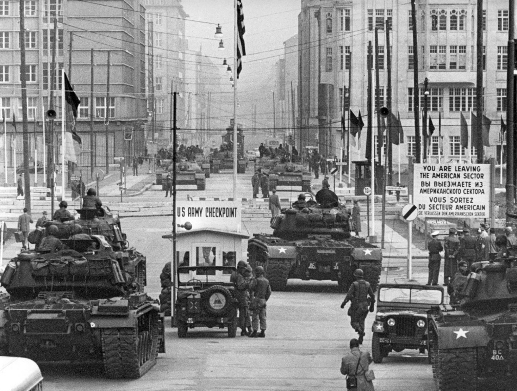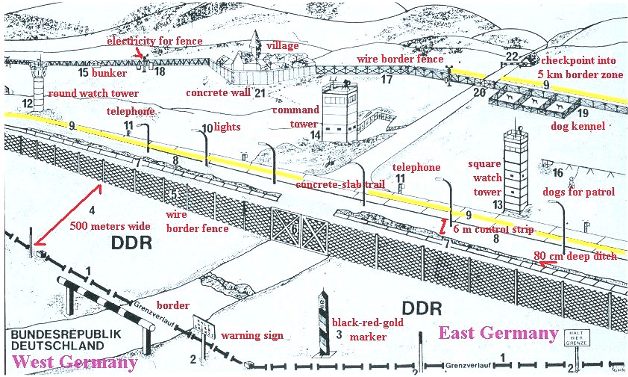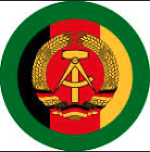Preface
Following the second World War, the former German borders were reduced and divided into four zones of occupying forces: Great Britain, France, the United States and the Soviet Union. The former capital, Berlin, was also divided into four sectors.
It did not take the Soviets long before they attempted to take all of Berlin through a blockade. (They also tried to take all of occupied Vienna.) Fortunately, the other Allies were able to defeat the Soviet aggression through the most miraculous airlift in history. (But that is a story for another time.)
It also did not take the citizens of what became East Germany and East Berlin to realize their brothers in the West were much better off. The resultant exodus of East Germans (estimated at 2.5 million) led to a closing of the borders and eventually to building a wall around West Berlin (155km) and along the “inter-German border” (1400km), which became known as the “Iron Curtain” to us and the” Death Strip” to all Germans. Hundreds of East Germans were killed or died in other ways directly connected to the German Democratic Republic (GDR) border regime between 1961 and 1989.
In the years following graduation, many of us 1969’ers served on “Freedom’s Frontier” in both West Germany and West Berlin, facing down the East German Border Guards (Grenztruppen der DDR or Grenzer, as they were called). I was one of the officers defending the West and consider myself fortunate to have spent 15 years doing so on both borders.
Between 1961 and 1988, it is estimated that well over 100,000 citizens of the GDR escaped or tried to escape across the inner-German border and the Berlin Wall. More than 600 of them were shot and killed by GDR border guards or died in other ways during their escape attempt, some drowning while trying to swim to the West, others setting off anti-personnel mines. 262 of those died at the Berlin Wall.
I, like many others often wondered how the Grenztruppen could have been so callous and brutal, killing their fellow countrymen and women. That so many East Germans were killed at the border is alarming and tragic and causes one to question how such a thing could happen. It is alarming and tragic because such atrocities can and still do occur. All it takes is a system of government that makes it lawful and possible to control, imprison and even kill its citizens. When the GDR realized they were bleeding their critical populace, they created an infrastructure to control and imprison them. One of the first steps was to create the “Iron Curtain” and the Berlin Wall, both enclosing what became known as the “Death Strip,” seen below.
Those of us serving in Germany knew about the border and “Death Strip” but not much about the Border Guards. I certainly did not, and it was not until after the “Wall” came down in 1990, that I had the opportunity to learn firsthand about the Grenztruppen and the other side of the border. When the III (GE) Corps Engineer organized a guided tour of the border by former Grenztruppen officers and non-commissioned officers for the V (US) Corps Engineer and staff, I was included, as the embedded liaison officer to the German Corps.
Our “tour guides” were now civilians disliked by East and West Germans alike, and unable to find jobs. Consequently, they were somewhat glad to be hired by the government to clear the old Death Strip of obstacles and unchartered minefields. They were in the process of doing so when we visited.
Their unenviable status in the new Germany was one of the things we learned during our 3-day tour on the border and 3 nights of staying with our guides in their former barracks. Of course, beer was served with our dinners and for several hours afterwards, which led to many stories and the realization that these “soldiers” were men doing what they were told and required by the laws of their land. More on that later, but first some background history.
After the war, the Soviet sector borders were manned by the Border Police (Grenzpolizei). In 1961, they were reorganized as the Border Troops of the GDR (Grenztruppen der DDR) and were moved from the Ministry of the Interior, which oversaw policing, to the Ministry of National Defense (MfNV) which oversaw the military. The Grenztruppen became the fourth service branch of the National People’s Army (NVA), the armed forces of the GDR. This is when the border was closed, first with barbed wire, which hindered but did not stop the exodus. Then cinder blocks were added and later the 13-foot-high concrete wall. One famous breach of the wire was on 15 August, 1961, when Konrad Schumann leapt across the closed border.
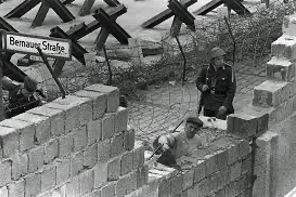
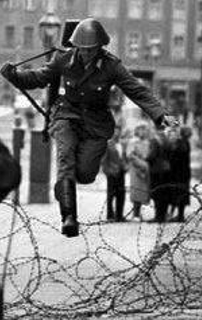
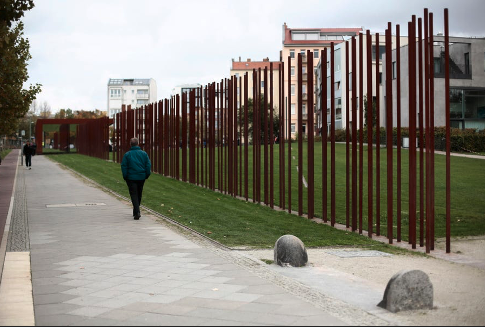
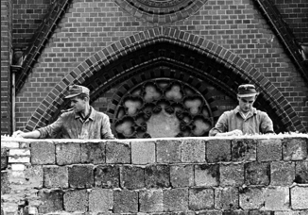
In 1973 the Grenztruppen were separated from the military and became directly subordinate to the MfNV, with their own patch. They remained in this status until
1 July 1990, when the GDR’s border control regime along the borders with West Germany and West Berlin was ended. At its peak, the Border Troops numbered approximately 47,000 personnel. In September 1990, shortly before the reunification of Germany, the Grenztruppen were disbanded; its border patrol duties along united Germany’s eastern frontiers were assumed by the Bundesgrenzschutz (Federal Border Guard – later the Bundespolizei or Federal Police). The Grenztruppen numbers were rapidly reduced. Over half (mostly leadership) were dismissed within 5 months. The “Death Strip” was abandoned, and the Bundeswehr gave the remaining border guards and other ex-East German soldiers the task of clearing the border fortifications, which was not completed until 1994. The scale of the task was immense, as not only the fortifications and uncharted minefields, which had shifted over 30 years, had to be cleared, but hundreds of roads and railway lines had to be rebuilt.
Over the 3 days of our tour, we gained the impression that many of the Grenztruppen were not particularly mean or brutal. It was the dictatorial government ordering them to use all means available to stop any attempt to leave the communist paradise, including shooting the traitors. While some soldiers probably did believe they were “defending against Western aggression,” not all did, and the GDR regime did not trust them.
We learned from our trip that individual guards were never sent out alone and were not told in advance what sector they were going to “defend.” No permanent teams were built; the individual border guard did not know his “comrade” well enough to allow collusion to plan or allow escapes, or to avoid shooting “to kill.” The “comrade” could even be a STASI spy (state security service, patterned after the Soviet KGB) checking on him.
Additionally, Border Guards were instructed daily that under no circumstances were fugitives to be allowed to escape across the border line, shooting them if necessary. Also, the incidents had to be kept secret as far as possible, even at the cost of the fugitives’ lives. (Some injured escapees were left in the “Death Strip” for hours while they bled out.) Border guards, successful in keeping fugitives from leaving GDR territory received commendations.
Fortunately, on 9 November 1989 at the Bornholmer crossing in Berlin, the officer in charge, LTC Jaeger received no guidance other than the impossible task to control the several thousand East Germans demanding to open the gates. More importantly, he did not receive the Schießbefehl (order to shoot) given by the communist leadership. According to one of our “guides,” a former colonel in the Grenztruppen, the general in charge refused to pass the order down. LTC Jaeger opened the gates and the rest is history.
Given all the precautions taken by the Grenztruppen leadership, the years of indoctrination and education (“brainwashing”) and the laws of the land that ordered guards to shoot traitors and suffer consequences for not doing so, it becomes somewhat clearer how countrymen could shoot each other … and still do today. That does not make it right, but the legalities involved tied up convictions for years.
